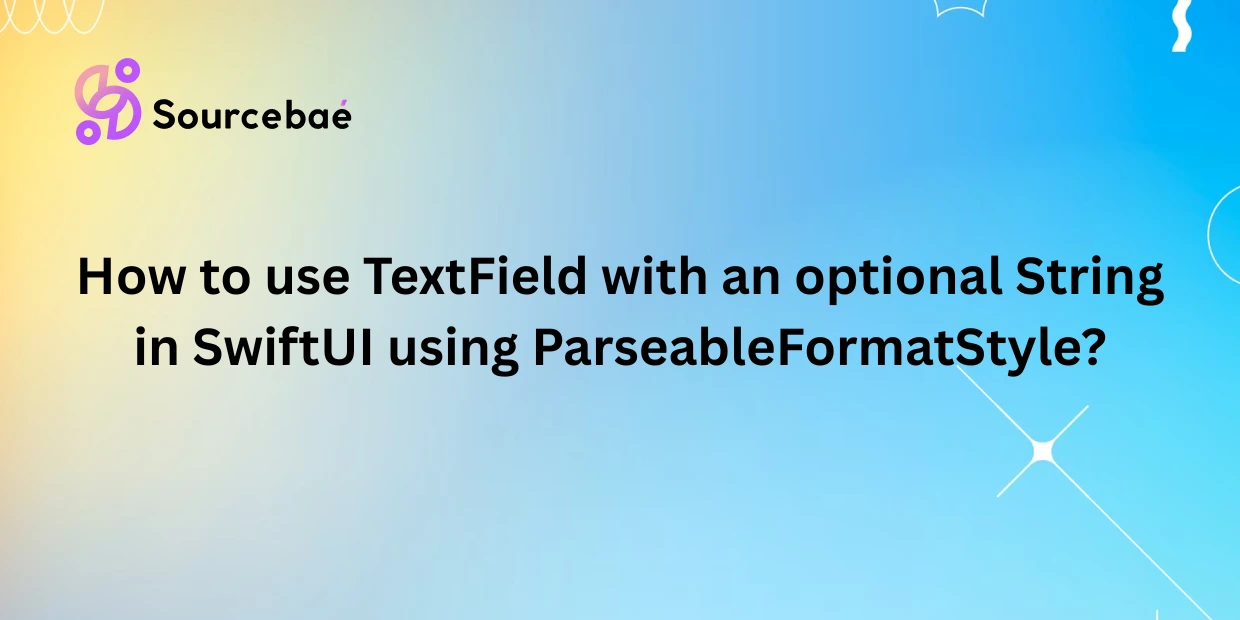Introduction
SwiftUI has transformed the way developers build user interfaces for iOS and Mac. Its declarative syntax simplifies many common coding tasks, including form data entry using components like TextField. However, working with optional strings (String?) in SwiftUI TextFields can sometimes become tricky, causing developers to run into type mismatches and runtime issues. Thankfully, Apple’s recent introduction of ParseableFormatStyle makes this much easier.
In this comprehensive guide, you’ll learn how to efficiently use a TextField with optional String values in SwiftUI, via the ParseableFormatStyle. Step-by-step, we’ll cover fundamental concepts, practical examples, best practices, common pitfalls, and troubleshooting advice—all designed to enhance your SwiftUI development skills.
What You’ll Learn:
- Fundamentals of SwiftUI’s TextField
- Handling optional (
String?) values in SwiftUI - Implementing and customizing
ParseableFormatStyle - Practical example implementation in a SwiftUI project
- Common mistakes and troubleshooting strategies
- FAQ addressing common SwiftUI TextField questions
Understanding SwiftUI TextField Basics
SwiftUI’s TextField is a user interface component enabling single-line text input. It binds directly to your state, updating your app’s interface as users type, making data entry intuitive and reactive.
Common use case examples:
- Usernames and passwords
- Profile editing screens
- Simple form entry
Here’s a straightforward example of TextField usage:
struct SimpleTextFieldView: View {
@State private var username: String = ""
var body: some View {
TextField("Enter username", text: $username)
.textFieldStyle(RoundedBorderTextFieldStyle())
.padding()
}
}
This example, however, handles non-optional Strings. Let’s explore dealing with optional values next.
The Need for Optional Strings in TextField
In Swift, we often use optional values (String?) to represent the absence of data clearly. For instance:
- Optional form fields (e.g., middle name, secondary address)
- User updates only certain profile fields
- APIs where certain attributes can be null
Connecting optional Strings directly to TextField introduces binding complexities. Developers frequently encounter compiler errors such as:
Cannot convert value of type 'Binding<String?>' to expected argument type 'Binding<String>'
Thus, managing optional (String?) becomes challenging without additional parsing and formatting strategies.
Introducing ParseableFormatStyle in Swift
ParseableFormatStyle introduced by Apple in Swift provides a structured way to parse and format strings with custom logic. It encapsulates formatting logic, enabling easy-handling optional Strings, empty strings, dates, numbers, and user-defined data types clearly.
This framework integration greatly simplifies:
- Input parsing and validation
- Formatting optional values clearly
- Clearly handling edge cases (e.g., empty input fields)
Check out: SwiftUI drag & drop implementation
Step-by-Step Implementation
Step A: Create a SwiftUI Project with Optional String Property
Begin by creating a new SwiftUI project in Xcode. Define your view model or state variable clearly to use an optional String.
@State private var optionalText: String? = nil
Step B: Binding Optional Strings with ParseableFormatStyle
Leverage SwiftUI’s built-in initializer with ParseableFormatStyle to easily connect this optional value.
Here’s how to establish this binding clearly:
struct ContentView: View {
@State private var optionalText: String? = nil
var body: some View {
VStack {
TextField("Enter optional text", value: $optionalText, format: .optionalString)
.textFieldStyle(RoundedBorderTextFieldStyle())
Text("Current Value: \(optionalText ?? "nil")")
}
.padding()
}
}
Step C: Defining Custom ParseableFormatStyle
Implement a custom ParseableFormatStyle to gracefully handle and format nil and non-nil Strings clearly.
extension FormatStyle where Self == OptionalStringParseableFormatStyle {
static var optionalString: OptionalStringParseableFormatStyle {
OptionalStringParseableFormatStyle()
}
}
struct OptionalStringParseableFormatStyle: ParseableFormatStyle {
func format(_ value: String?) -> String {
value ?? ""
}
var parseStrategy: OptionalStringParseStrategy {
OptionalStringParseStrategy()
}
}
struct OptionalStringParseStrategy: ParseStrategy {
func parse(_ value: String) throws -> String? {
value.isEmpty ? nil : value
}
}
This implementation clearly translates empty strings from the user (text field) back into nil and vice-versa.
Detailed Example and Code Explanation
Let’s clearly discuss the example provided above:
optionalTextis declared as an optional String (String?) to represent missing or existing values clearly.- The custom
optionalStringformat translates nil to empty, enabling seamless user interaction. - The parse method converts empty strings entered by the user into nil values, ensuring a clean data model.
This provides a structured, safe, intuitive way to handle optional String inputs clearly.
Check out: SwiftUI Vs UIKit
Best Practices and Recommended Patterns
When adopting ParseableFormatStyle for optional values:
- Clearly handle parsing to translate empty input into nil.
- Always define clear validation or error-handling logic.
- Use View Models separation clearly, isolating business logic from Views.
- Always define custom formats for specialized inputs (e.g., phone numbers, emails).
Common Pitfalls and Troubleshooting
Issue: Binding Error “Cannot convert Binding<String?> to Binding”
Solution: Always use .init(binding:format:) with ParseableFormatStyle, as direct bindings only accept non-optional Strings.
Issue: Unexpected nil values causing UI crashes
Solution: Safely unwrap optional Strings explicitly within View logic or use nil-coalescing operators (??).
FAQ Section
What is ParseableFormatStyle in Swift?
ParseableFormatStyle is Apple’s structured way of formatting values into Strings for display, and parsing Strings back into values for use in your data model.
Why can’t I bind a TextField directly to a String? in SwiftUI?
Direct binding in SwiftUI expects a non-optional String binding. Using ParseableFormatStyle overcomes this limitation, providing clear conversion logic.
Do I always need ParseableFormatStyle for optional Strings?
Not necessarily; it is helpful when you clearly expect situations of empty user input, explicitly mapping these to nil.
Can I create my custom ParseableFormatStyle?
Yes, creating custom formats is encouraged clearly, especially when handling specialized data formatting and parsing requirement.
Why might my optional binding fail to update?
Check whether your parse method correctly returns nil when strings are empty clearly, and verify your binding is correctly attached in your SwiftUI View.
Additional Resources & Further Reading
- SwiftUI
TextFieldDocumentation - WWDC Video – SwiftUI Bindings and State Management
- FormatStyle Documentation
Conclusion
Leveraging SwiftUI’s powerful ParseableFormatStyle for managing optional String values significantly simplifies TextField data entry. By clearly defining your formatting and parsing logic, you minimize user frustration, enhance app reliability, and write maintainable code.
Adhering closely to these best practices gives your SwiftUI TextFields robust handling for optional values, reducing unexpected behaviors clearly. Now you have the essential guidelines to confidently implement your custom format strategies in your future SwiftUI apps.
If you’ve got questions or insights, feel free to leave a comment or share this article to help peers master this important SwiftUI topic!
Happy SwiftUI coding!






